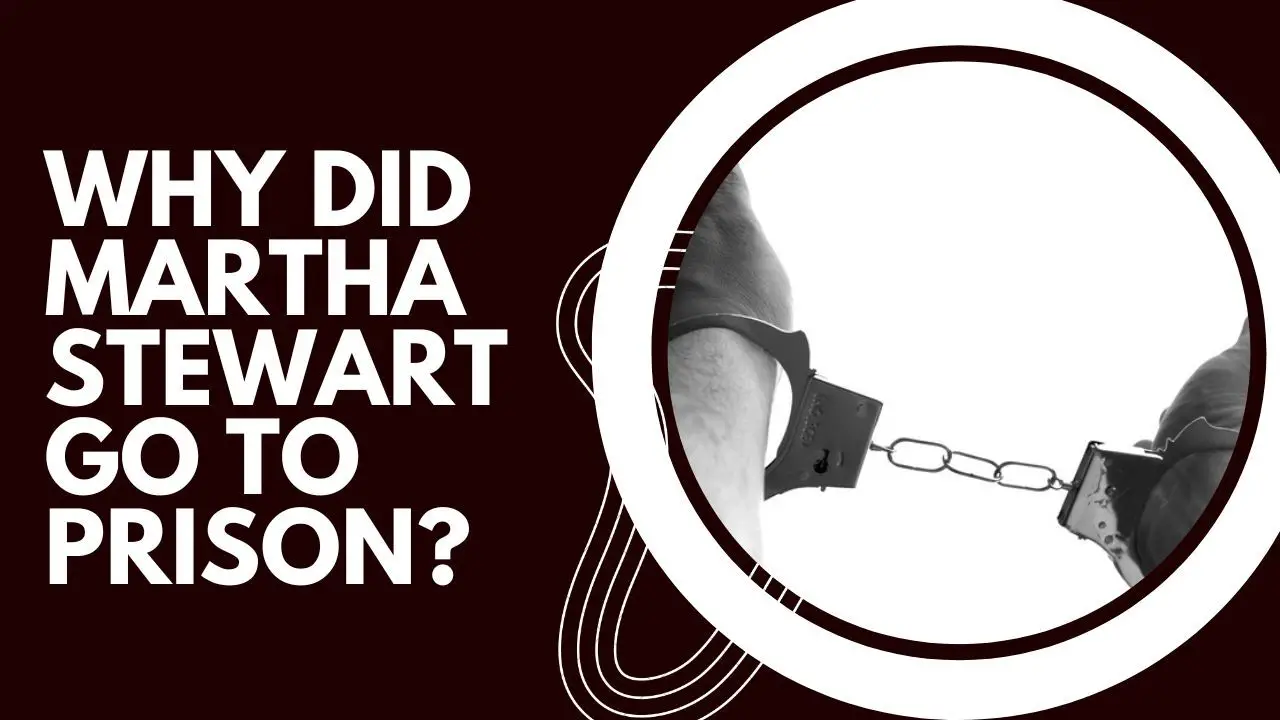Why Did Martha Stewart Go to Prison?
Why Did Martha Stewart Go to Prison? In this article, we have discussed Martha Stewart, who is an American retail businesswoman, model, writer, and television personality. We answered some questions like: Why Did Martha sentence to prison? How much time does she was there in prison?

For those that have not been keeping in touch with the business media, Martha Stewart’s name rings a bell in a grimmer context. In fact, beyond the fact that this famous businesswoman and television personality was sent to jail for fraud related to a famous stock market incident.
Stewart is an American retail businesswoman, model, writer, and television personality. She is the founder of Martha Stewart Living Omnimedia, and gained success through a wide range of business ventures, which include publishing, broadcasting, merchandising, and e-commerce.
She has authored numerous bestselling books and is the publisher of Martha Stewart Living magazine. She also hosted two syndicated television programs namely Martha Stewart Living, which aired from 1993 to 2004, and Martha (a cooking show), which aired from 2005 to 2012.
Early Life Of Martha Stewart
Martha Helen Stewart (née Kostyra) was born in Jersey City, New Jersey, on 3rd August 1941 to parents of Polish heritage, her father, Edward Kostyra (1912–1979) and mother, Martha (née Ruszkowski; 1914–2007) were both teachers though her father later becoming a pharmaceutical salesman. She is the second of six children.
She adopted the name "Grace" for her Catholic confirmation name.
At age 10, she worked as the occasional babysitter for the children of baseball players Mickey Mantle, Yogi Berra, and Gil McDougald, all belonging to the New York Yankees. She also began modeling.
When Stewart was 15, she was featured in a television commercial for Unilever. She appeared in television commercials and magazines, including one of Tareyton's "Us Tareyton smokers would rather fight than switch!" cigarette advertisements. During her time at college, she supplemented her scholarship money through modeling jobs at Chanel, which paid her $50/hour, a lot of money at that time.
Stewart graduated from Nutley High School and attended Barnard College of Columbia University, with plans to major in chemistry, but later switching to art, history, and architectural history.
During college, she met Andrew Stewart, who finished his law degree at Yale Law School. They got married in July 1961. A year after her marriage to Andrew, she returned to Barnard to graduate with a double major in history and architectural history.
Career Beginnings of Martha Stewart
In 1967, Stewart stepped into a second career as a stockbroker, her father-in-law's profession.
Andrew and Martha Stewart later moved to Westport, Connecticut. They purchased and restored the 1805 farmhouse located on Turkey Hill Road that would later serve as the model for the TV studio of Martha Stewart Living.
In 1976, Stewart started a catering business in her basement with a friend from her modeling days named Norma Collier.
The business quickly became successful but became acrimonious when Collier alleged that Stewart was difficult to work with and claimed she had been taking catering jobs on the side.
Stewart soon bought Collier's portion of the business from her. Later, Stewart was also hired as the manager of a gourmet food store, the Market Basket, but had a disagreement with the owners at the mini-mall, after which she was forced out, resulting in her opening her store.
In 1977, Stewart was introduced to Alan Mirken, head of Crown Publishing Group, who was greatly impressed by Stewart's talent as a chef and hostess. He later contacted her to publish a cookbook featuring recipes and photos from Stewart's parties. Her first book, Entertaining (released on December 13, 1982), was ghostwritten by Elizabeth Hawes.
Later Career of Martha Stewart
In 1990, Stewart signed with Time Publishing Ventures, an American worldwide mass media corporation, to develop a new magazine, Martha Stewart Living, for which Stewart would be the editor-in-chief. The first issue came out in late 1990 with an initial rate base of 250,000. Circulation peaked in 2002 at more than 2 million copies per issue.
In 1993, Stewart began a weekly half-hour television program called Martha Stewart Living, based on her magazine.
In September 1997, with the assistance of business partner Sharon Patrick, Stewart secured funding to purchase the numerous television, print, and merchandising ventures related to the Martha Stewart brand and consolidated them into a new company called Martha Stewart Living Omnimedia (MSLO). She became the chairwoman, president, and CEO of the new company and Patrick served as Chief Operations Officer.
On 19th October 1999, Martha Stewart Living Omnimedia went public on the New York Stock Exchange (NYSE, nicknamed "The Big Board") under the ticker symbol MSO. The initial public offering was set at 18 USD per share (an equivalent of $29 in 2021) and rallied to 38 USD (an equivalent of $62 in 2021) by the end of trading, establishing Stewart as a billionaire on paper and also the first female self-made billionaire in the United States.
However, the stock price slowly dropped to $16 per share by February 2002. Stewart was then and continues to be the company's majority shareholder, commanding 96% control of voting power.
ImClone Stock Trading Case
According to a report by the U.S. Securities and Exchange Commission (SEC), Stewart prevented a loss of $45,673 by selling all 3,928 shares of her ImClone Systems (a biopharmaceutical company) stock on 27th December 2001 after receiving material, nonpublic information from Peter Bacanovic, her broker at Merrill Lynch (an American investment management and wealth management division of Bank of America). A day later, the stock value fell 16%.
In the following months, Stewart drew heavy media scrutiny, which included a Newsweek cover headlined "Martha's Mess."
On 3rd October 2002, Stewart resigned from her position, which had been held for four months, on the New York Stock Exchange board of directors, following a deal that the prosecutors had made with Douglas Faneuil, an assistant to her broker.
On 4th June 2003, Stewart was indicted by the government on nine counts, including charges of securities fraud, lying about a stock sale, conspiracy, and obstruction of justice. Stewart voluntarily resigned as CEO and Chairwoman of MSLO but held on as a chief creative officer.
She went on trial in January 2004. Prosecutors showed that Peter Bacanovic had ordered his assistant Faneuil to tell Stewart that the CEO of ImClone, Samuel D. Waksal, had been selling all his shares in advance of an adverse Food and Drug Administration ruling. The FDA action, therefore, was expected to cause ImClone shares to decline.
Imprisonment of Martha Stewart
After a highly publicized six-week jury trial during which she maintained her innocence, Stewart was found guilty in March 2004 of felony charges of conspiracy to obstruct, constriction of an agency proceeding, and falsified statements to federal investigators.
She was sentenced in July 2004 to serve a five-month term in a federal correctional facility and two years of supervised release (including five months of electronic monitoring).
Stewart also had to pay a fine of $30,000.
She was ordered to report her prison sentence before 2:00 p.m. on 8th October 2004. By 27th September 2004, Stewart had received the BOP ID 55170-054. At about 6:15 a.m. on 8th October 2004, she reported to her Federal Prison Camp, Alderson. Stewart was released from the facility at 12:30 AM on 4th March 2005.
She was later placed on a two-year term of supervised release; for five of these months, she served home confinement at her residence in Bedford, New York, with electronic monitoring.
You can also read articles related to this topic;
- 5 Worst Prisons In The Province of Ontario
- Can You Go to Prison For Not Paying Taxes?
- What to Wear to Visit Someone in Jail: What Can I Wear to Go to a Maximum Security Prison?
- Phillips State Prison: Visiting Information, History of This Facility, Inmates Phone, Mail, And FAQ About This Prison
- Pickaway County Active Inmates: How to search for Active Inmates of Pickaway County Prison
- Trumbull County Jail: Brief Overview Visiting Hours, Inmate Phones, And Sherif's Location
- Worst Prisons In The State Of West Virginia
- Marion County Inmate Roster: Complete Information, Sheriff's Office, Visiting Hours
